Advances in Self-Powered Ultraviolet Photodetectors Based on P-N Heterojunction Low-Dimensional Nanostructures
Abstract
:1. Introduction
2. Improving the Performance of Self-Powered UV Photodetectors Based on p-n Heterojunction Low-Dimensional Nanostructures from Different Aspects
2.1. Construct Low-Dimensional Semiconductor Nanostructures
2.2. Expand the p-n Heterojunction Interface
2.3. Improve the Crystalline Quality of Semiconductors
2.4. Utilize Transfer of Photogenerated Carriers or Enhance the Built-In Electric Field
2.5. Adjust the Bandgap of Semiconductors for Deep UV Detection
3. Summary and Perspectives
Funding
Conflicts of Interest
References
- Chen, J.X.; Ouyang, W.X.; Yang, W.; He, J.H.; Fang, X.S. Recent progress of heterojunction ultraviolet photodetectors: Materials, integrations, and applications. Adv. Funct. Mater. 2020, 16, 1909909. [Google Scholar] [CrossRef]
- Xie, C.; Lu, X.T.; Tong, X.W.; Zhang, Z.X.; Liang, F.X.; Liang, L.; Luo, L.B.; Wu, Y.C. Recent progress in solar-blind deep-ultraviolet photodetectors based on inorganic ultrawide bandgap semiconductors. Adv. Funct. Mater. 2019, 29, 1806006. [Google Scholar] [CrossRef]
- Nasiri, N.; Jin, D.Y.; Tricoli, A. Nanoarchitechtonics of visible-blind ultraviolet photodetector materials: Critical features and nano-microfabrication. Adv. Opt. Mater. 2019, 7, 1800580. [Google Scholar] [CrossRef] [Green Version]
- Chen, H.Y.; Liu, H.; Zhang, Z.M.; Hu, K.; Fang, X.S. Nanostructured photodetectors: From ultraviolet to terahertz. Adv. Mater. 2016, 28, 403–433. [Google Scholar] [CrossRef] [PubMed]
- Soci, C.; Zhang, A.; Xiang, B.; Dayeh, S.A.; Aplin, D.P.R.; Park, J.; Bao, X.Y.; Lo, Y.H.; Wang, D. ZnO Nanowire UV photodetectors with high internal gain. Nano Lett. 2007, 7, 1003–1009. [Google Scholar] [CrossRef]
- Li, Z.L.; Li, Z.Q.; Zuo, C.L.; Fang, X.S. Application of nanostructured TiO2 in UV photodetectors: A review. Adv. Mater. 2022, 34, 2109083. [Google Scholar] [CrossRef]
- Shi, L.; Nihtianov, S. Comparative study of silicon-based ultraviolet photodetectors. IEEE Sens. J. 2012, 12, 2453–2459. [Google Scholar] [CrossRef]
- Liu, K.W.; Sakurai, M.; Aono, M. ZnO-based ultraviolet photodetectors. Sensors 2010, 10, 8604–8634. [Google Scholar] [CrossRef] [Green Version]
- Aggarwal, N.; Gupta, G. Enlightening gallium nitride-based UV photodetectors. J. Mater. Chem. C 2020, 8, 12348–12354. [Google Scholar] [CrossRef]
- Zhou, A.F.; Velazquez, R.; Wang, X.P.; Feng, P.X. Nanoplasmonic 1D diamond UV photodetectors with high performance. ACS Appl. Mater. Interfaces 2019, 11, 38068–38074. [Google Scholar] [CrossRef]
- Monroy, E.; Omnès, F.; Calle, F. Wide-bandgap semiconductor ultraviolet photodetectors. Semicond. Sci. Technol. 2003, 18, R33–R51. [Google Scholar] [CrossRef]
- Yang, F.; Guo, J.M.; Zhao, L.; Shang, W.Y.; Gao, Y.Y.; Zhang, S.; Gu, G.Q.; Zhang, B.; Cui, P.; Cheng, G.; et al. Tuning oxygen vacancies and improving UV sensing of ZnO nanowire by micro-plasma powered by a triboelectric nanogenerator. Nano Energy 2020, 67, 104210. [Google Scholar] [CrossRef]
- Peng, M.Z.; Liu, Y.D.; Yu, A.F.; Zhang, Y.; Liu, C.H.; Liu, J.Y.; Wu, W.; Zhang, K.; Shi, X.Q.; Kou, J.Z.; et al. Flexible self-powered GaN ultraviolet photoswitch with piezo-phototronic effect enhanced on/off ratio. ACS Nano 2016, 10, 1572–1579. [Google Scholar] [CrossRef] [PubMed]
- Pang, X.C.; He, Y.J.; Jung, J.; Lin, Z.Q. 1D nanocrystals with precisely controlled dimensions, compositions, and architectures. Science 2016, 353, 1268–1272. [Google Scholar] [CrossRef] [PubMed] [Green Version]
- Zheng, L.X.; Deng, X.L.; Wang, Y.Z.; Chen, J.X.; Fang, X.S.; Wang, L.; Shi, X.W.; Zheng, H.J. Self-powered flexible TiO2 fibrous photodetectors: Heterojunction with P3HT and boosted responsivity and selectivity by Au nanoparticles. Adv. Funct. Mater. 2020, 30, 2001604. [Google Scholar] [CrossRef]
- Pearton, S.J.; Yang, J.C.; Cary, P.H.; Ren, F.; Kim, J.; Tadjer, M.J.; Mastro, M.A. A review of Ga2O3 materials, processing, and devices. Appl. Phys. Rev. 2018, 5, 011301. [Google Scholar] [CrossRef] [Green Version]
- Li, L.D.; Lou, Z.; Chen, H.R.; Shi, R.L.; Shen, G.Z. Stretchable SnO2-CdS interlaced-nanowire film ultraviolet photodetectors. Sci. China Mater. 2019, 62, 1139–1150. [Google Scholar] [CrossRef] [Green Version]
- Ye, Q.N.; Zhang, X.; Yao, R.H.; Luo, D.X.; Liu, X.Z.; Zou, W.X.; Guo, C.X.; Xu, Z.H.; Ning, H.L.; Peng, J.B. Research and progress of transparent, flexible tin oxide ultraviolet photodetector. Crystals 2021, 11, 1479. [Google Scholar] [CrossRef]
- Shao, D.L.; Yu, M.P.; Sun, H.T.; Hu, T.; Lian, J.; Sawyer, S. High responsivity, fast ultraviolet photodetector fabricated from ZnO nanoparticle-graphene core-shell structures. Nanoscale 2013, 5, 3664–3667. [Google Scholar] [CrossRef]
- Zhang, Y.; Peng, M.F.; Liu, Y.N.; Zhang, T.T.; Zhu, Q.Q.; Lei, H.; Liu, S.N.; Tao, Y.; Li, L.; Wen, Z.; et al. Flexible self-powered real-time ultraviolet photodetector by coupling triboelectric and photoelectric effects. ACS Appl. Mater. Interfaces 2020, 12, 19384–19392. [Google Scholar] [CrossRef]
- Wen, Z.; Shen, Q.Q.; Sun, X.H. Nanogenerators for self-powered gas sensing. Nano-Micro Lett. 2017, 9, 45. [Google Scholar] [CrossRef] [PubMed]
- Wen, Z.; Yeh, M.H.; Guo, H.Y.; Wang, J.; Zi, Y.L.; Xu, W.D.; Deng, J.N.; Zhu, L.; Wang, X.; Hu, C.G.; et al. Self-powered textile for wearable electronics by hybridizing fiber-shaped nanogenerators, solar cells, and supercapacitors. Sci. Adv. 2016, 2, e1600097. [Google Scholar] [CrossRef] [PubMed] [Green Version]
- Ouchi, H.; Mukai, T.; Kamei, T.; Okamural, M. Silicon p-n junction photodiodes sensitive to ultraviolet radiation. IEEE Trans. Electron Devices 1979, 26, 1965–1969. [Google Scholar] [CrossRef]
- Zheng, H.Y.; Li, Y.J.; Liu, H.B.; Yin, X.D.; Li, Y.L. Construction of heterostructure materials toward functionality. Chem. Soc. Rev. 2011, 40, 4506–4524. [Google Scholar] [CrossRef]
- Wang, L.; Li, Z.; Li, M.; Li, S.; Lu, Y.C.; Qi, N.; Zhang, J.; Xie, C.; Wu, C.Y.; Luo, L.B. Self-powered filterless narrow-band p-n heterojunction photodetector for low background limited near-infrared image sensor application. ACS Appl. Mater. Interfaces 2020, 12, 21845–21853. [Google Scholar] [CrossRef]
- Guo, Y.B.; Xu, L.; Liu, H.B.; Li, Y.J.; Che, C.M.; Li, Y.L. Self-assembly of functional molecules into 1D crystalline nanostructures. Adv. Mater. 2015, 27, 985–1013. [Google Scholar] [CrossRef]
- Li, H.; Su, S.B.; Liang, C.H.; Zhang, T.; An, X.H.; Huang, M.Z.; Tao, H.H.; Ma, X.; Ni, Z.H.; Tian, H.; et al. UV rewritable hybrid graphene/phosphor p–n junction photodiode. ACS Appl. Mater. Interfaces 2019, 11, 43351–43358. [Google Scholar] [CrossRef]
- Kwon, Y.T.; Kang, S.O.; Cheon, J.A.; Song, Y.; Lee, J.J.; Choa, Y.H. Fabrication of a Graphene/ZnO based pn junction device and its ultraviolet photoresponse properties. Appl. Surf. Sci. 2017, 415, 2–7. [Google Scholar] [CrossRef]
- Masai, H.; Terao, J.; Seki, S.; Nakashima, S.; Kiguchi, M.; Okoshi, K.; Fujihara, T.; Tsuji, Y. Synthesis of one-dimensional metal-containing insulated molecular wire with versatile properties directed toward molecular electronics materials. J. Am. Chem. Soc. 2014, 136, 1742–1745. [Google Scholar] [CrossRef]
- Li, J.X.; Li, T.L.; Xu, T.L.; Kiristi, M.; Liu, W.J.; Wu, Z.G.; Wang, G. Magneto-acoustic hybrid nanomotor. Nano Lett. 2015, 15, 4814–4821. [Google Scholar] [CrossRef]
- Ouyang, W.X.; Chen, J.X.; Shi, Z.F.; Fang, X.S. Self-powered UV photodetectors based on ZnO nanomaterials. Appl. Phys. Rev. 2021, 8, 031315. [Google Scholar] [CrossRef]
- Cai, S.; Xu, X.J.; Yang, W.; Chen, J.X.; Fang, X.S. Materials and designs for wearable photodetectors. Adv. Mater. 2019, 31, 1808138. [Google Scholar] [CrossRef] [PubMed]
- Zhou, J.Y.; Chen, L.L.; Wang, Y.Q.; He, Y.M.; Pan, X.J.; Xie, E.Q. An overview on emerging photoelectrochemical self-powered ultraviolet photodetectors. Nanoscale 2016, 8, 50–73. [Google Scholar] [CrossRef] [PubMed]
- Teng, F.; Hu, K.; Ouyang, W.X.; Fang, X.S. Photoelectric detectors based on inorganic p-type semiconductor materials. Adv. Mater. 2018, 30, 1706262. [Google Scholar] [CrossRef] [PubMed]
- Liu, H.W.; Zhu, X.L.; Sun, X.X.; Zhu, C.G.; Huang, W.; Zhang, X.H.; Zheng, B.Y.; Lou, Z.X.; Luo, Z.Y.; Wang, X.; et al. Self-powered broad-band photodetectors based on vertically stacked WSe2/Bi2Te3 p-n heterojunctions. ACS Nano 2019, 13, 13573–13580. [Google Scholar] [CrossRef] [PubMed]
- Li, C.; Huang, W.C.; Gao, L.F.; Wang, H.D.; Hu, L.P.; Chen, T.T.; Zhang, H. Recent advances in solution-processed photodetectors based on inorganic and hybrid photo-active materials. Nanoscale 2020, 12, 2201–2227. [Google Scholar] [CrossRef]
- Deng, J.; Su, Y.D.; Liu, D.; Yang, P.D.; Liu, B.; Liu, C. Nanowire photoelectrochemistry. Chem. Rev. 2019, 119, 9221–9259. [Google Scholar] [CrossRef] [Green Version]
- Ou Yang, W.X.; Teng, F.; He, J.H.; Fang, X.S. Enhancing the photoelectric performance of photodetectors based on metal oxide semiconductors by charge-carrier engineering. Adv. Funct. Mater. 2019, 29, 1807672. [Google Scholar] [CrossRef]
- Yun, S.N.; Zhang, Y.W.; Xu, Q.; Liu, J.M.; Qin, Y. Recent advance in new-generation integrated devices for energy harvesting and storage. Nano Energy 2019, 60, 600–619. [Google Scholar] [CrossRef]
- Zhu, H.; Shan, C.X.; Yao, B.; Li, B.H.; Zhang, J.Y.; Zhao, D.X.; Shen, D.Z.; Fan, X.W. High spectrum selectivity ultraviolet photodetector fabricated from an n-ZnO/p-GaN heterojunction. J. Phys. Chem. C 2008, 112, 20546–20548. [Google Scholar] [CrossRef]
- Garnett, E.; Yang, P.D. Light trapping in silicon nanowire solar cells. Nano Lett. 2010, 10, 1082–1087. [Google Scholar] [CrossRef] [PubMed]
- Qin, L.Q.; Shao, D.L.; Shing, C.; Sawyer, S. Wavelength selective p-GaN/ZnO colloidal nanoparticle heterojunction photodiode. Appl. Phys. Lett. 2013, 102, 071106. [Google Scholar] [CrossRef]
- Ni, P.N.; Shan, C.X.; Wang, S.P.; Liu, X.Y.; Shen, D.Z. Self-powered spectrum-selective photodetectors fabricated from n-ZnO/p-NiO core–shell nanowire arrays. J. Mater. Chem. C 2013, 1, 4445–4449. [Google Scholar] [CrossRef]
- Lao, C.S.; Park, M.S.; Kuang, Q.; Deng, Y.L.; Sood, A.K.; Polla, D.L.; Wang, Z.L. Giant enhancement in UV response of ZnO nanobelts by polymer surface-functionalization. J. Am. Chem. Soc. 2007, 129, 12096–12097. [Google Scholar] [CrossRef] [Green Version]
- Yang, S.X.; Yang, H.Y.; Ma, H.Y.; Guo, S.; Cao, F.; Gong, J.; Deng, Y.L. Manganese oxide nanocomposite fabricated by a simple solid-state reaction and its ultraviolet photoresponse property. Chem. Commun. 2011, 47, 2619–2621. [Google Scholar] [CrossRef]
- Wang, H.L.; Zhang, L.S.; Chen, Z.G.; Hu, J.Q.; Li, S.J.; Wang, Z.H.; Liu, J.S.; Wang, X.C. Semiconductor heterojunction photocatalysts: Design, construction, and photocatalytic performances. Chem. Soc. Rev. 2014, 43, 5234–5244. [Google Scholar] [CrossRef]
- Hanan Alzahrani, H.; Sulaiman, K.; Mahmoud, A.H.; Bahabry, R.R. Ultrasensitive self-powered UV photodetector based on a novel p-n heterojunction of solution-processable organic semiconductors. Synth. Met. 2021, 278, 116830. [Google Scholar] [CrossRef]
- Li, J.H.; Li, Y.L.; Xu, J.T.; Luscombe, C.K. Self-assembled amphiphilic block copolymers/CdTe nanocrystals for efficient aqueous-processed hybrid solar cells. ACS Appl. Mater. Interfaces 2017, 9, 17942–17948. [Google Scholar] [CrossRef]
- Im, S.H.; Lim, C.S.; Chang, J.A.; Lee, Y.H.; Maiti, N.; Kim, H.J.; Nazeeruddin, M.K.; Grätzel, M.; Seok, S. Toward interaction of sensitizer and functional moieties in hole-transporting materials for efficient semiconductor-sensitized solar cells. Nano Lett. 2011, 11, 4789–4793. [Google Scholar] [CrossRef]
- Zhao, Y.S.; Fu, H.B.; Peng, A.D.; Ma, Y.; Liao, Q.; Yao, J.N. Construction and optoelectronic properties of organic one-dimensional nanostructures. Acc. Chem. Res. 2010, 43, 409–418. [Google Scholar] [CrossRef]
- Liu, H.B.; Xu, J.L.; Li, Y.J.; Li, Y.L. Aggregate nanostructures of organic molecular materials. Acc. Chem. Res. 2010, 43, 1496–1508. [Google Scholar] [CrossRef] [PubMed]
- Chen, N.; Qian, X.M.; Lin, H.W.; Liu, H.B.; Li, Y.L. Growing uniform copolymer nanowire arrays for high stability and efficient field emission. J. Mater. Chem. 2012, 22, 11068–11072. [Google Scholar] [CrossRef]
- Zheng, L.X.; Yu, P.P.; Hu, K.; Teng, F.; Chen, H.Y.; Fang, X.S. Scalable production, self-powered TiO2 nanowells/organic hybrids UV photodetectors with tunable performances. ACS Appl. Mater. Interfaces 2016, 8, 33924–33932. [Google Scholar] [CrossRef] [PubMed]
- Li, F.P.; Peng, W.B.; Pan, Z.J.; He, Y.N. Optimization of Si/ZnO/PEDOT:PSS tri-layer heterojunction photodetector by piezo-phototronic effect using both positive and negative piezoelectric charges. Nano Energy 2018, 48, 27–34. [Google Scholar] [CrossRef]
- Zu, X.H.; Wang, H.; Yi, G.B.; Zhang, Z.; Jiang, X.M.; Gong, J.; Luo, H.S. Self-powered UV photodetector based on heterostructured TiO2 nanowire arrays and polyaniline nanoflower arrays. Synthetic Met. 2015, 200, 58–65. [Google Scholar] [CrossRef]
- Mojtabavi, E.A.; Nasirian, S. A self-powered UV photodetector based on polyaniline/titania nanocomposite with long-term stability. Opt. Mater. 2019, 94, 28–34. [Google Scholar] [CrossRef]
- Ouyang, B.S.; Zhang, K.W.; Yang, Y. Self-powered UV photodetector array based on P3HT/ZnO nanowire array heterojunction. Adv. Mater. Technol. 2017, 2, 1700208. [Google Scholar] [CrossRef]
- Su, L.X.; Yang, W.; Cai, J.; Chen, H.Y.; Fang, X.S. Self-Powered ultraviolet photodetectors driven by built-in electric field. Small 2017, 13, 1701687. [Google Scholar] [CrossRef] [Green Version]
- Lin, H.W.; Chen, K.; Li, M.K.; Ji, B.B.; Jia, Y.H.; Liu, X.Y.; Li, J.L.; Song, W.Q.; Guan, C.L. Constructing a green light photodetector on inorganic/organic semiconductor homogeneous hybrid nanowire arrays with remarkably enhanced photoelectric response. ACS Appl. Mater. Interfaces 2019, 11, 10146–10152. [Google Scholar] [CrossRef]
- Lin, H.W.; Liu, H.B.; Qian, X.M.; Chen, S.H.; Li, Y.J.; Li, Y.L. Synthesizing axial inserting p-n heterojunction nanowire arrays for realizing synergistic performance. Inorg. Chem. 2013, 52, 6969–6974. [Google Scholar] [CrossRef]
- Lin, H.W.; Liu, H.B.; Qian, X.M.; Lai, S.W.; Li, Y.J.; Chen, N.; Ouyang, C.B.; Che, C.M.; Li, Y.L. Constructing a blue light photodetector on inorganic/organic p-n heterojunction nanowire arrays. Inorg. Chem. 2011, 50, 7749–7753. [Google Scholar] [CrossRef] [PubMed]
- Pedram, G.; Federica, R.; You, S.J.; Illia, D.; Gilzad, K.M.; Lucia, P.A.; Isabella, C.; Nils, A.; Graziella, M.; Alberto, V. ZnO-Cu2O core-shell nanowires as stable and fast response photodetectors. Nano Energy 2018, 51, 308–316. [Google Scholar]
- Li, Y.; DiStefano, J.G.; Murthy, A.A.; Cain, J.D.; Hanson, E.D.; Li, Q.Q.; Castro, F.C.; Chen, X.Q.; Dravid, V.P. Superior plasmonic photodetectors based on Au@MoS2 core-shell heterostructures. ACS Nano 2017, 11, 10321–10329. [Google Scholar] [CrossRef] [PubMed]
- Zhao, B.; Wang, F.; Chen, H.Y.; Wang, Y.P.; Jiang, M.M.; Fang, X.S.; Zhao, D.X. Solar-blind avalanche photodetector based on single ZnO-Ga2O3 core-shell microwire. Nano Lett. 2015, 15, 3988–3993. [Google Scholar] [CrossRef] [PubMed]
- Chen, N.; Qian, X.M.; Lin, H.W.; Liu, H.B.; Li, Y.J.; Li, Y.L. Synthesis and characterization of axial heterojunction inorganic-organic semiconductor nanowire arrays. Dalton Trans. 2011, 40, 10804–10808. [Google Scholar] [CrossRef]
- Guo, Y.B.; Tang, Q.X.; Liu, H.B.; Zhang, Y.J.; Li, Y.L.; Hu, W.P.; Wang, S.; Zhu, D.B. Light-controlled organic/inorganic P-N junction nanowires. J. Am. Chem. Soc. 2008, 130, 9198–9199. [Google Scholar] [CrossRef]
- Xue, Z.; Yang, H.; Gao, J.; Li, J.F.; Chen, Y.H.; Jia, Z.Y.; Li, Y.J.; Liu, H.B.; Yang, W.S.; Li, Y.L.; et al. Controlling the interface areas of organic/inorganic semiconductor heterojunction nanowires for high-performance diodes. ACS Appl. Mater. Interfaces 2016, 8, 21563–21569. [Google Scholar] [CrossRef]
- Panigrahi, S.; Basak, D. Core-shell TiO2@ZnO nanorods for efficient ultraviolet photodetection. Nanoscale 2011, 3, 2336–2341. [Google Scholar] [CrossRef]
- Zhang, F.; Ding, Y.; Zhang, Y.; Zhang, X.L.; Wang, Z.L. Piezo-phototronic effect enhanced visible and ultraviolet photodetection using a ZnO-CdS core-shell micro/nanowire. ACS Nano 2012, 6, 9229–9236. [Google Scholar] [CrossRef]
- Cai, J.; Xu, X.J.; Su, L.X.; Yang, W.; Chen, H.Y.; Zhang, Y.; Fang, X.S. Self-powered n-SnO2/p-CuZnS core-shell microwire UV photodetector with optimized performance. Adv. Opt. Mater. 2018, 6, 1800213. [Google Scholar] [CrossRef]
- Li, S.; Zhi, Y.S.; Lu, C.; Wu, C.; Yan, Z.Y.; Liu, Z.; Yang, J.; Chu, X.L.; Guo, D.Y.; Li, P.G.; et al. Broadband ultraviolet self-powered photodetector constructed on Exfoliated β-Ga2O3/CuI core-shell microwire heterojunction with superior reliability. J. Phys. Chem. Lett. 2021, 12, 447–453. [Google Scholar] [CrossRef] [PubMed]
- You, D.T.; Xu, C.X.; Zhao, J.; Zhang, W.; Qin, F.F.; Chen, J.P.; Shi, Z.L. Vertically aligned ZnO/Ga2O3 core/shell nanowire arrays as self-driven superior sensitivity solar-blind photodetectors. J. Mater. Chem. C 2019, 7, 3056–3063. [Google Scholar] [CrossRef]
- Zheng, Y.L.; Li, Y.; Tang, X.; Wang, W.L.; Li, G.Q. A self-powered high-performance UV photodetector based on core-shell GaN/MoO3-x nanorod array heterojunction. Adv. Opt. Mater. 2020, 8, 2000197. [Google Scholar] [CrossRef]
- Hong, Q.S.; Cao, Y.; Xu, J.; Lu, H.M.; He, J.H.; Sun, J.L. Self-powered ultrafast broadband photodetector based on p-n heterojunctions of CuO/Si nanowire array. ACS Appl. Mater. Interfaces 2014, 6, 20887–20894. [Google Scholar] [CrossRef]
- Hatch, S.M.; Briscoe, J.; Dunn, S. A self-powered ZnO-nanorod/CuSCN UV photodetector exhibiting rapid response. Adv. Mater. 2013, 25, 867–871. [Google Scholar] [CrossRef]
- Liu, P.; Peng, H.S.; Fang, X.S. A real-time wearable UV-radiation monitor based on a high-performance p-CuZnS/n-TiO2 photodetector. Adv. Mater. 2018, 30, 1803165. [Google Scholar]
- Ghamgosar, P.; Rigoni, F.; Kohan, M.G.; You, S.J.; Morales, E.A.; Mazzaro, R.; Morandi, V.; Almqvist, N.; Concina, I.; Vomiero, A. Self-powered photodetectors based on core-shell ZnO-Co3O4 nanowire heterojunctions. ACS Appl. Mater. Interfaces 2019, 11, 23454–23462. [Google Scholar] [CrossRef]
- Xu, X.Z.; Zhang, X.J.; Deng, W.; Huang, L.M.; Wang, W.; Jie, J.S.; Zhang, X.H. Saturated vapor-assisted growth of single-crystalline organic-inorganic hybrid perovskite nanowires for high-performance photodetectors with robust stability. ACS Appl. Mater. Interfaces 2018, 10, 10287–10295. [Google Scholar] [CrossRef]
- Yang, S.X.; Wang, C.; Ataca, C.; Li, Y.; Chen, H.; Cai, H.; Suslu, A.; Grossman, J.C.; Jiang, C.B.; Liu, Q.; et al. Self-driven photodetector and ambipolar transistor in atomically thin GaTe-MoS2 p-n vdW heterostructure. ACS Appl. Mater. Interfaces 2016, 8, 2533–2539. [Google Scholar] [CrossRef]
- Lian, Q.; Zhu, X.T.; Wang, X.D.; Bai, W.; Yang, J.; Zhang, Y.Y.; Qi, R.J.; Huang, R.; Hu, W.D.; Tang, X.D.; et al. Ultrahigh-detectivity photodetectors with van der waals epitaxial CdTe single-crystalline films. Small 2019, 15, 1900236. [Google Scholar] [CrossRef]
- Dao, T.D.; Dang, C.T.T.; Han, G.; Hoang, C.V.; Yi, W.; Narayanamurti, V.; Nagao, T. Chemically synthesized nanowire TiO2/ZnO core-shell p-n junction array for high sensitivity ultraviolet photodetector. Appl. Phys. Lett. 2013, 103, 193119. [Google Scholar] [CrossRef]
- Xu, J.L.; Bu, X.H. Optical properties and applications of crystalline materials. Adv. Opt. Mater. 2021, 9, 2102394. [Google Scholar] [CrossRef]
- Deng, W.; Jie, J.S.; Shang, Q.X.; Wang, J.C.; Zhang, X.J.; Yao, S.W.; Zhang, Q.; Zhang, X.H. Organic nanowire/crystalline silicon p-n heterojunctions for high-sensitivity, broadband photodetectors. ACS Appl. Mater. Interfaces 2015, 7, 2039–2045. [Google Scholar] [CrossRef]
- Wang, H.B.; Chen, H.Y.; Li, L.; Wang, Y.F.; Su, L.X.; Bian, W.P.; Li, B.S.; Fang, X.S. High responsivity and high rejection ratio self-powered solarblind ultraviolet photodetector based on PEDOT:PSS/β-Ga2O3 organic/inorganic p-n junction. J. Phys. Chem. Lett. 2019, 10, 6850–6856. [Google Scholar] [CrossRef] [PubMed]
- Teng, F.; Ouyang, W.X.; Li, Y.M.; Zheng, L.X.; Fang, X.S. Novel structure for high performance UV photodetector based on BiOCl/ZnO hybrid film. Small 2017, 13, 1700156. [Google Scholar] [CrossRef] [PubMed]
- Sang, L.W.; Liao, M.Y.; Masatomo, S. A comprehensive review of semiconductor ultraviolet photodetectors: From thin film to one-dimensional nanostructures. Sensors 2013, 13, 10482–10518. [Google Scholar] [CrossRef] [PubMed]
- Sarkar, S.; Basak, D. Self powered highly enhanced dual wavelength ZnO@CdS core-shell nanorod arrays photodetector: An intelligent pair. ACS Appl. Mater. Interfaces 2015, 7, 16322–16329. [Google Scholar] [CrossRef]
- Guo, D.Y.; Su, Y.L.; Shi, H.Z.; Li, P.G.; Zhao, N.; Ye, J.H.; Wang, S.L.; Liu, A.P.; Chen, Z.W.; Li, C.R.; et al. Self-powered ultraviolet photodetector with superhigh photoresponsivity (3.05 A/W) based on the GaN/Sn:Ga2O3 pn junction. ACS Nano 2018, 12, 12827–12835. [Google Scholar] [CrossRef]
- Mufioz, E.; Monroy, E.; Calle, F.; Omnes, F.; Gibart, P. AlGaN Photodiodes for Monitoring Solar UV Radiation. J Geophys. Res. 2000, 105, 4865–4871. [Google Scholar]
- Goswami, L.; Aggarwal, N.; Vashishtha1, P.; Jain1, S.K.; Nirantar, S.; Ahmed, J.; Khan, M.A.M.; Pandey, R.; Gupta, G. Fabrication of GaN nano-towers based self-powered UV photodetector. Sci. Rep. 2021, 11, 10859. [Google Scholar] [CrossRef]
- Zheng, W.; Huang, F.; Zheng, R.S.; Wu, H.L. Low-dimensional structure vacuum-ultraviolet-sensitive (λ < 200 nm) photodetector with fast-response speed based on high-quality AlN micro/nanowire. Adv. Mater. 2015, 27, 3921–3927. [Google Scholar] [CrossRef] [PubMed]
- Cai, Q.; You, H.F.; Guo, H.; Wang, J.; Liu, B.; Xie, Z.L.; Chen, D.J.; Lu, H.; Youdou Zheng, Y.D.; Zhang, R. Progress on AlGaN-based solar-blind ultraviolet photodetectors and focal plane arrays. Light Sci. Appl. 2021, 10, 94. [Google Scholar] [CrossRef] [PubMed]
- Zou, Y.N.; Zhang, Y.; Hu, Y.M.; Gu, H.S. Ultraviolet detectors based on wide bandgap semiconductor nanowire: A review. Sensors 2018, 18, 2072. [Google Scholar] [CrossRef] [PubMed] [Green Version]
- Tak, B.R.; Singh, R. Ultra-low noise and self-powered β-Ga2O3 deep ultraviolet photodetector array with large linear dynamic range. ACS Appl. Electron. Mater. 2021, 3, 2145–2151. [Google Scholar] [CrossRef]
- Zhang, Y.; Song, W.D. High performance self-powered CuZnS/GaN UV photodetectors with ultrahigh on/off ratio (3 × 108). J. Mater. Chem. C 2021, 9, 4799–4807. [Google Scholar] [CrossRef]
- Li, J.; Xi, X.; Lin, S.; Ma, Z.H.; Li, X.D.; Zhao, L.X. Ultrahigh sensitivity Graphene/nanoporous GaN ultraviolet photodetectors. ACS Appl. Mater. Interfaces 2020, 12, 11965–11971. [Google Scholar] [CrossRef]
- Xiao, Y.; Liu, L.; Ma, Z.H.; Meng, B.; Qin, S.J.; Pan, G.B. High-performance self-powered ultraviolet photodetector based on nano-porous GaN and CoPc p-n vertical heterojunction. Nanomaterials 2019, 9, 1198. [Google Scholar] [CrossRef] [Green Version]
- Pant, R.; Singh, D.K.; Chowdhury, A.M.; Roul, B.; Nanda, K.K.; Krupanidhi, S.B. Next-generation self-powered and ultrafast photodetectors based on III-nitride hybrid Structures. APL Mater. 2020, 8, 020907. [Google Scholar] [CrossRef]
- Wang, D.H.; Huang, C.; Liu, X.; Zhang, H.C.; Yu, H.B.; Fang, S.; Ooi, B.S.; Mi, Z.; He, J.H.; Sun, H.D. Highly uniform, self-assembled AlGaN nanowires for self-powered solar-blind photodetector with fast-response speed and high responsivity. Adv. Opt. Mater. 2021, 9, 2000893. [Google Scholar] [CrossRef]
- Chen, X.X.; Xiao, X.H.; Shi, Z.F.; Du, R.; Li, X.J. Self-powered ultraviolet photodetection realized by GaN/Si nanoheterostructure based on silicon nanoporous pillar array. J. Alloys Compd. 2018, 767, 368–373. [Google Scholar] [CrossRef]
- Cicek, E.; McClintock, R.; Cho, C.Y.; Rahnema, B.; Razeghi, M. AlxGa1-xN-based back-illuminated solar-blind photodetectors with external quantum efficiency of 89%. Appl. Phys. Lett. 2013, 103, 191108. [Google Scholar] [CrossRef]
- Jiang, M.; Zhao, Y.K.; Bian, L.F.; Yang, W.X.; Zhang, J.Y.; Wu, Y.Y.; Zhou, M.; Lu, S.L.; Qin, H. Self-powered photoelectrochemical (Al, Ga)N photodetector with an ultrahigh ultraviolet/visible reject ratio and a quasi-invisible functionality for 360° omnidirectional detection. ACS Photonics 2021, 8, 3282–3290. [Google Scholar] [CrossRef]
- Pandit, B.; Schubert, E.F.; Cho1, J. Dual-functional ultraviolet photodetector with graphene electrodes on AlGaN/GaN heterostructure. Sci. Rep. 2020, 10, 22059. [Google Scholar] [CrossRef] [PubMed]
- Li, Y.J.; Xu, L.; Liu, H.B.; Li, Y.L. Graphdiyne and graphyne: From theoretical predictions to practical construction. Chem. Soc. Rev. 2014, 43, 2572–2586. [Google Scholar] [CrossRef] [PubMed]
- Huang, C.S.; Li, Y.J.; Wang, N.; Xue, Y.R.; Zuo, Z.C.; Liu, H.B.; Li, Y.L. Progress in research into 2D graphdiyne-based materials. Chem. Rev. 2018, 118, 7744–7803. [Google Scholar] [CrossRef] [PubMed]
- Jin, Z.W.; Zhou, Q.; Chen, Y.H.; Mao, P.; Li, H.; Liu, H.B.; Wang, J.Z.; Li, Y.L. Graphdiyne: ZnO nanocomposites for high-performance UV photodetectors. Adv. Mater. 2016, 28, 3697–3702. [Google Scholar] [CrossRef]
- Hui, L.; Xue, Y.R.; Huang, B.L.; Yu, H.D.; Zhang, C.; Zhang, D.Y.; Jia, D.Z.; Zhao, Y.J.; Li, Y.J.; Liu, H.B.; et al. Overall water splitting by graphdiyne-exfoliated and -sandwiched layered double-hydroxide nanosheet arrays. Nat. Commun. 2018, 9, 5309. [Google Scholar] [CrossRef] [Green Version]
- Xue, Y.R.; Huang, B.L.; Yi, Y.P.; Guo, Y.; Zuo, Z.C.; Li, Y.J.; Jia, Z.Y.; Liu, H.B.; Li, Y.L. Anchoring zero valence single atoms of nickel and iron on graphdiyne for hydrogen evolution. Nat. Commun. 2018, 9, 1460. [Google Scholar] [CrossRef]
- Li, Y.; Zhang, M.J.; Hu, X.L.; Li, X.D.; Li, R.; Yu, L.M.; Fan, X.H.; Wang, N.Y.; Huang, C.S.; Li, Y.L. Graphdiyne visible-light photodetector with ultrafast detectivity. Adv. Opt. Mater. 2021, 9, 2001916. [Google Scholar] [CrossRef]
- Liu, C.; Han, X.; Shi, R.C.; Qi, S.M.; Chen, S.H.; Xu, L.; Xu, J.L. Nonlinear optics of graphdiyne. Mater. Chem. Front. 2021, 5, 6413–6428. [Google Scholar] [CrossRef]
- Zhang, Y.; Huang, P.; Guo, J.; Shi, R.C.; Huang, W.C.; Shi, Z.; Wu, L.M.; Zhang, F.; Gao, L.F.; Li, C.; et al. Photodetectors: Graphdiyne-based flexible photodetectors with highresponsivity and detectivity. Adv. Mater. 2020, 32, 2070175. [Google Scholar] [CrossRef]
- Qiao, H.; Huang, Z.Y.; Ren, X.H.; Liu, S.H.; Zhang, Y.P.; Qi, X.; Zhang, H. Self-powered photodetectors based on 2D materials. Adv. Opt. Mater. 2020, 8, 1900765. [Google Scholar] [CrossRef]
- Wang, Y.; Meng, J.H.; Tian, Y.; Chen, Y.N.; Wang, G.K.; Yin, Z.G.; Jin, P.; You, J.B.; Wu, J.L.; Zhang, X.G. Deep ultraviolet photodetectors based on carbon-doped two-dimensional hexagonal boron nitride. ACS Appl. Mater. Interfaces 2020, 12, 27361–27367. [Google Scholar] [CrossRef] [PubMed]
- Li, L.; Wang, W.K.; Chai, Y.; Li, H.Q.; Tian, M.L.; Zhai, T.Y. Few-layered PtS2 phototransistor on h-BN with high gain. Adv. Funct. Mater. 2017, 27, 1701011. [Google Scholar] [CrossRef]
- Zdanowicz, E.; Herman, A.P.; Opołczyńska, K.; Gorantla, S.; Olszewski, W.; Serafińczuk, J.; Hommel, D.; Kudrawiec, R. Toward h-BN/GaN schottky diodes: Spectroscopic study on the electronic phenomena at the interface. ACS Appl. Mater. Interfaces 2022, 14, 6131–6137. [Google Scholar] [CrossRef] [PubMed]
- Kumar, R.; Sahoo, S.; Joanni, E.; Singh, R.K.; Yadav, R.M.; Verma, R.K.; Singh, D.P.; Tan, W.K.; Pino, A.P.; Moshkalev, S.A.; et al. A review on synthesis of graphene, h-BN and MoS2 for energy storage applications: Recent progress and perspectives. Nano Res. 2019, 12, 2655–2694. [Google Scholar] [CrossRef]
- Kumar, A.; Khan, M.A.; Kumar, M. Recent advances in UV photodetectors based on 2D materials: A review. J. Phys. D Appl. Phys. 2022, 55, 133002. [Google Scholar] [CrossRef]
- Tian, W.; Wang, Y.D.; Chen, L.; Li, L. Self-powered nanoscale photodetectors. Small 2017, 13, 1701848. [Google Scholar] [CrossRef] [Green Version]
- Sun, C.J.; Jiang, Y.Z.; Cui, M.H.; Qiao, L.; Wei, J.L.; Huang, Y.M.; Zhang, L.; He, T.W.; Li, S.S.; Hsu, H.Y.; et al. High-performance large-area quasi-2D perovskite light-emitting diodes. Nat. Commun. 2021, 12, 2207. [Google Scholar] [CrossRef]
- Su, L.; Zhao, Z.X.; Li, H.Y.; Yuan, J.; Wang, Z.L.; Cao, G.Z.; Zhu, G. High-performance organolead halide perovskite-based self-powered triboelectric photodetector. ACS Nano 2015, 9, 11310–11316. [Google Scholar] [CrossRef]
- Guo, B.B.; Yin, J.C.; Li, N.; Fu, Z.X.; Han, X.; Xu, J.L.; Bu, X.H. Recent progress in luminous particle-encapsulated host-guest metal-organic frameworks for optical applications. Adv. Opt. Mater. 2021, 9, 2100283. [Google Scholar] [CrossRef]
- Liu, Y.; Cui, J.Y.; Du, K.; He, T.; He, Z.F.; Zhou, Q.H.; Yang, Z.L.; Deng, Y.Z.; Chen, D.; Zuo, X.B.; et al. Efficient blue light-emitting diodes based on quantum-confined bromide perovskite nanostructures. Nat. Photonics 2019, 13, 760. [Google Scholar] [CrossRef]
- Shen, K.; Xu, H.; Li, X.; Guo, J.; Sathasivam, S.; Wang, M.Q.; Ren, A.B.; Choy, K.L.; Parkin, I.P.; Guo, Z.X.; et al. Flexible and self-powered photodetector arrays based on all-inorganic CsPbBr3 quantum dots. Adv. Mater. 2020, 32, 2000004. [Google Scholar] [CrossRef] [PubMed] [Green Version]
- Cao, F.R.; Meng, L.X.; Wang, M.; Tian, W.; Li, L. Gradient energy band driven high-performance self-powered perovskite/CdS photodetector. Adv. Mater. 2019, 31, e1806725. [Google Scholar] [CrossRef]
- Li, C.L.; Han, C.; Zhang, Y.B.; Zang, Z.G.; Wang, M.; Tang, X.S.; Du, J.H. Enhanced photoresponse of self-powered perovskite photodetector based on ZnO nanoparticles decorated CsPbBr3 films. Sol. Energy Mater. Sol. Cells 2017, 172, 341–346. [Google Scholar] [CrossRef]
- Ji, C.M.; Dey, D.; Peng, Y.; Liu, X.T.; Li, L.N.; Luo, J.H. Ferroelectricity-driven self-powered ultraviolet photodetection with strong polarization sensitivity in a two-dimensional halide hybrid perovskite. Angew. Chem. Int. Ed. 2020, 59, 18933–18937. [Google Scholar] [CrossRef]
- Wang, L.; Xue, Y.X.; Cui, M.H.; Huang, Y.M.; Xu, H.Y.; Qin, C.C.; Yang, J.E.; Dai, H.T.; Yuan, M.J. A chiral reduced-dimension perovskite for an efficient flexible circularly polarized light photodetector. Angew. Chem. Int. Ed. 2020, 132, 6442–6450. [Google Scholar] [CrossRef]
- Michael, E.; Mathias, S.; Phaedon, A. Black phosphorus photodetector for multispectral, high-resolution imaging. Nano Lett. 2014, 14, 6414–6417. [Google Scholar]
- Youngblood, N.; Chen, C.; Koester, S.J.; Li, M. Waveguide-integrated black phosphorus photodetector with high responsivity and low dark current. Nat. Photonics 2015, 9, 247–252. [Google Scholar] [CrossRef]
- Chen, X.L.; Lu, X.B.; Deng, B.C.; Sinai, O.; Shao, Y.C.; Li, C.; Yuan, S.F.; Tran, V.; Watanabe, K.; Taniguchi, T.; et al. Widely tunable black phosphorus mid-infrared photodetector. Nat. Commun. 2017, 8, 1672. [Google Scholar] [CrossRef] [Green Version]
- Yuan, H.T.; Liu, X.G.; Afshinmanesh, F.; Li, W.; Xu, G.; Sun, J.; Lian, B.; Curto, A.G.; Ye, G.J.; Hikita, Y.; et al. Polarization-sensitive broadband photodetector using a black phosphorus vertical p-n junction. Nat. Nanotechnol. 2015, 10, 707–713. [Google Scholar] [CrossRef] [PubMed] [Green Version]
- Zhang, Y.; Zhang, F.; Xu, Y.G.; Huang, W.C.; Wu, L.M.; Zhang, Y.P.; Zhang, X.W.; Zhang, H. Self-healable black phosphorus photodetectors. Adv. Funct. Mater. 2019, 29, 1906610. [Google Scholar] [CrossRef]
- Zhang, L.; Wang, B.; Zhou, Y.H.; Wang, C.; Chen, X.L.; Zhang, H. Synthesis techniques, optoelectronic properties, and broadband photodetection of thin-film black phosphorus. Adv. Opt. Mater. 2020, 8, 2000045. [Google Scholar] [CrossRef]
- Kim, H.; Uddin, S.Z.; Lien, D.H.; Yeh, M.; Azar, N.S.; Balendhran, S.; Kim, T.; Gupta, N.; Rho, Y.; Grigoropoulos, C.P.; et al. Actively variable-spectrum optoelectronics with black phosphorus. Nature 2021, 596, 232. [Google Scholar] [CrossRef]
- Long, M.S.; Gao, A.Y.; Wang, P.; Xia, H.; Ott, C.; Pan, C.; Fu, Y.J.; Liu, E.F.; Chen, X.S.; Lu, W.; et al. Room temperature high-detectivity mid-infrared photodetectors based on black arsenic phosphorus. Sci. Adv. 2017, 3, 1700589. [Google Scholar] [CrossRef] [Green Version]
- Velusamy, D.B.; Haque, M.A.; Parida, M.R.; Zhang, F.; Wu, T.; Mohammed, O.F.; Alshareef, H.N. 2D organic-inorganic hybrid thin films for flexible UV-Visible photodetectors. Adv. Funct. Mater. 2017, 27, 1605554. [Google Scholar] [CrossRef]
- Wang, X.D.; Wang, P.; Wang, J.L.; Hu, W.D.; Zhou, X.H.; Guo, N.; Huang, H.; Sun, S.; Shen, H.; Lin, T.; et al. Ultrasensitive and broadband MoS2 photodetector driven by ferroelectrics. Adv. Mater. 2015, 27, 6575–6581. [Google Scholar] [CrossRef] [PubMed] [Green Version]
- Fazio, D.D.; Goykhman, I.; Yoon, D.; Bruna, M.; Eiden, A.; Milana, S.; Sassi, U.; Barbone, M.; Dumcenco, D.; Marinov, K.; et al. High responsivity, large-area graphene/MoS2 flexible photodetectors. ACS Nano 2016, 10, 8252–8262. [Google Scholar] [CrossRef] [Green Version]
- Kufer, D.; Nikitskiy, I.; Lasanta, T.; Navickaite, G.; Koppens, F.H.L.; Konstantatos, G. Hybrid 2D-0D MoS2-PbS quantum dot photodetectors. Adv. Mater. 2015, 27, 176–180. [Google Scholar] [CrossRef]
- Nasr, J.R.; Simonson, N.; Oberoi, A.; Horn, M.W.; Robinson, J.A.; Das, S. Low-power and ultra-thin MoS2 photodetectors on glass. ACS Nano 2020, 14, 15440–15449. [Google Scholar] [CrossRef]
- Wang, l.; Jie, J.S.; Shao, Z.B.; Zhang, Q.; Zhang, X.H.; Wang, Y.M.; Sun, Z.; Lee, S.T. MoS2/Si heterojunction with vertically standing layered structure for ultrafast, high-detectivity, self-driven visible-near infrared photodetectors. Adv. Funct. Mater. 2015, 25, 2910–2919. [Google Scholar] [CrossRef]
- Xu, H.; Han, X.Y.; Dai, X.; Liu, W.; Wu, J.; Zhu, J.T.; Kim, D.Y.; Zou, G.F.; Sablon, K.A.; Sergeev, A.; et al. High detectivity and transparent few-layer MoS2/glassy-graphene heterostructure photodetectors. Adv. Mater. 2018, 30, 1706561. [Google Scholar] [CrossRef] [PubMed]
- Dodda, A.; Oberoi, A.; Sebastian, A.; Choudhury, T.H.; Redwing, J.M.; Das, S. Stochastic resonance in MoS2 photodetector. Nat. Commun. 2020, 11, 4406. [Google Scholar] [CrossRef] [PubMed]
- Zou, Z.X.; Liang, J.W.; Zhang, X.H.; Ma, C.; Xu, P.; Yang, X.; Zeng, Z.X.S.; Sun, X.X.; Zhu, C.G.; Liang, D.L.; et al. Liquid-metal-assisted growth of vertical GaSe/MoS2 p-n heterojunctions for sensitive self-driven photodetectors. ACS Nano 2021, 15, 10039–10047. [Google Scholar] [CrossRef]
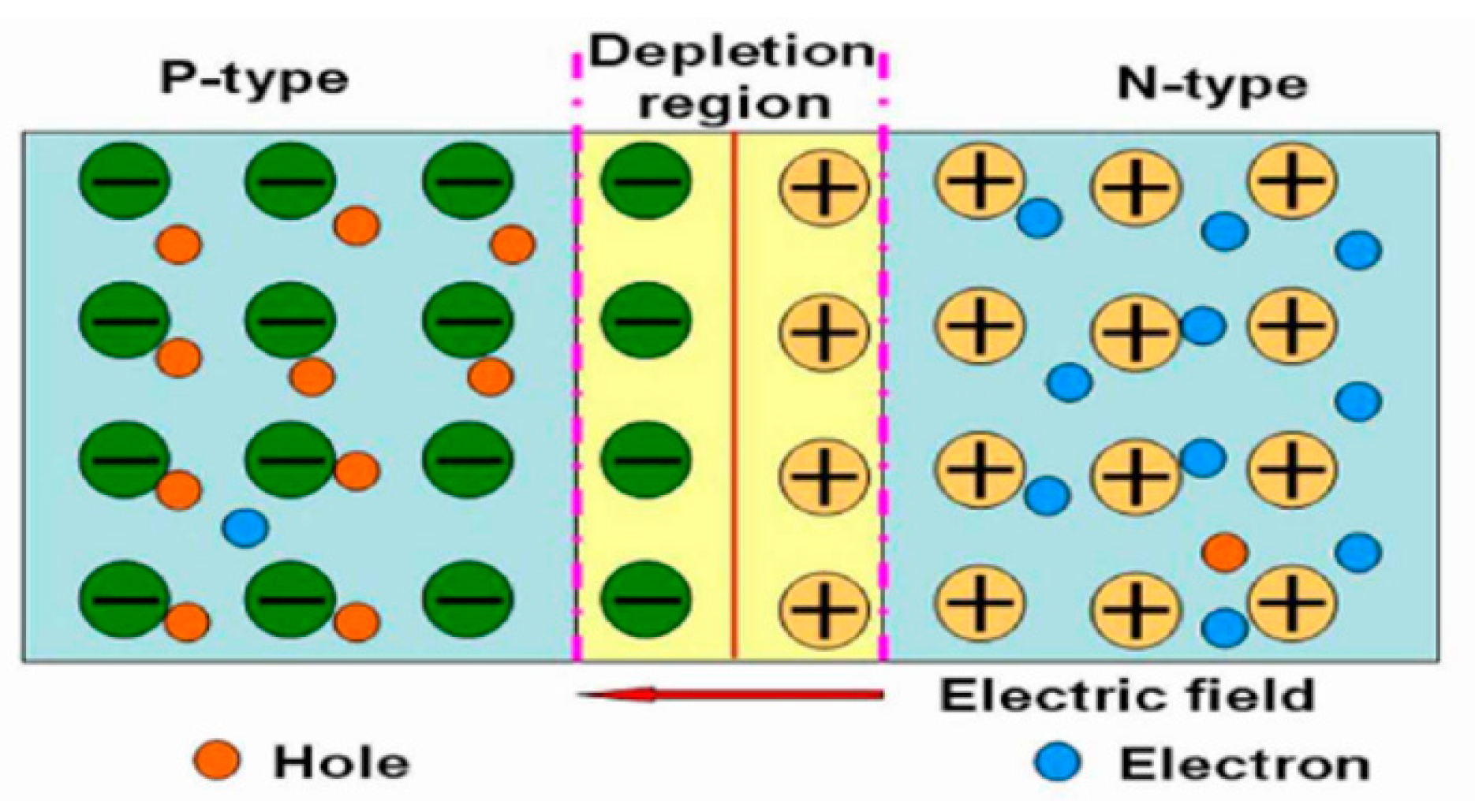
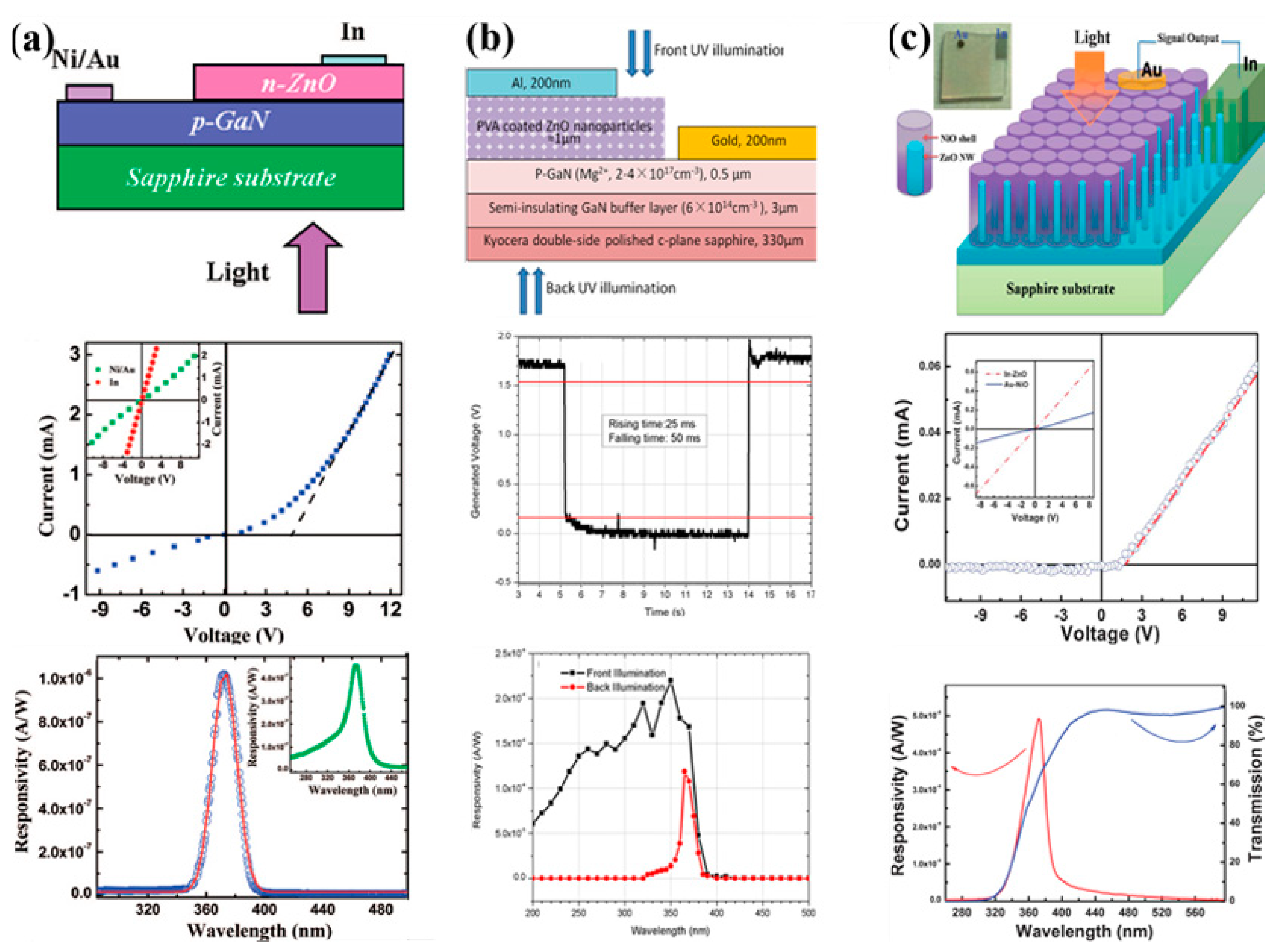
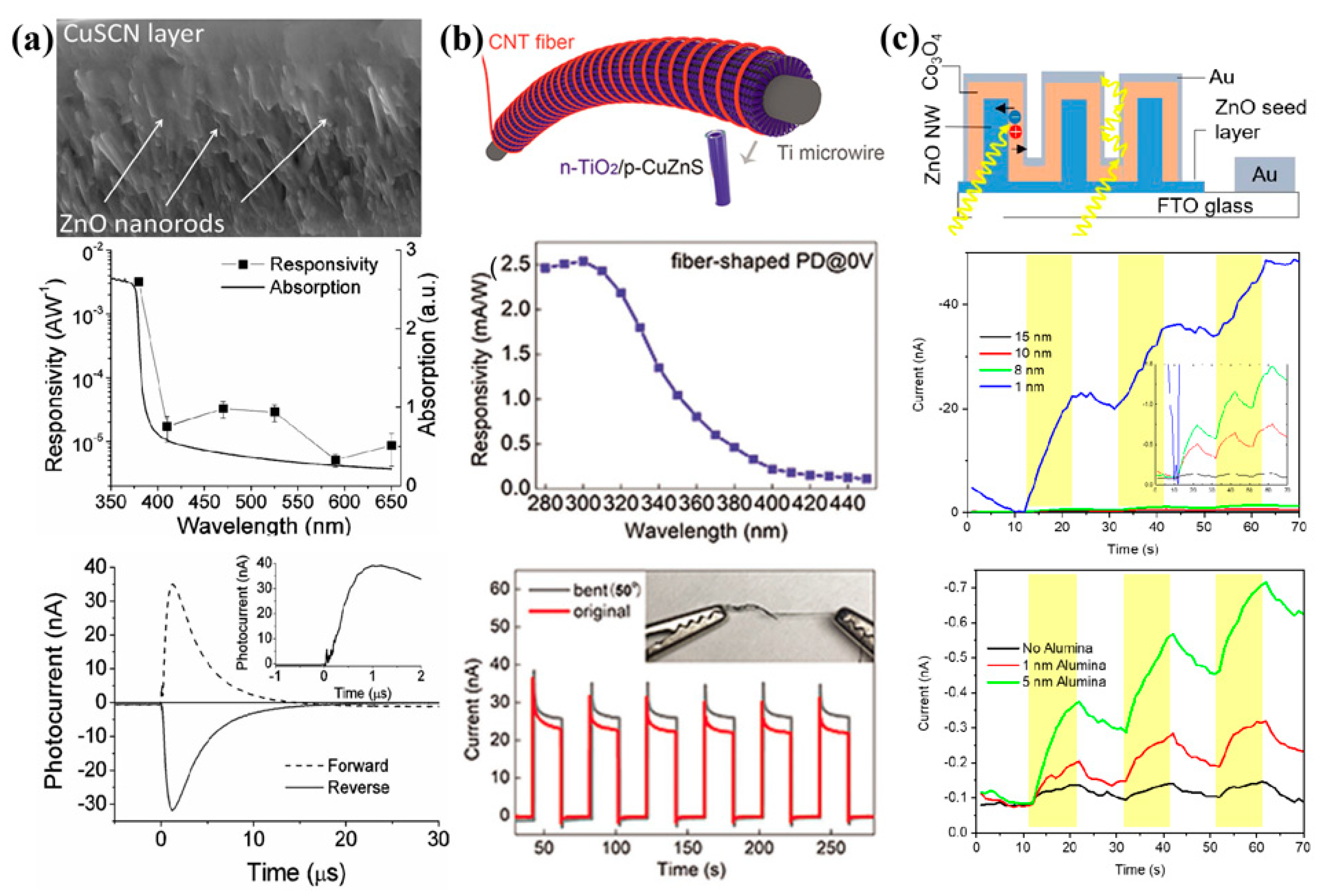
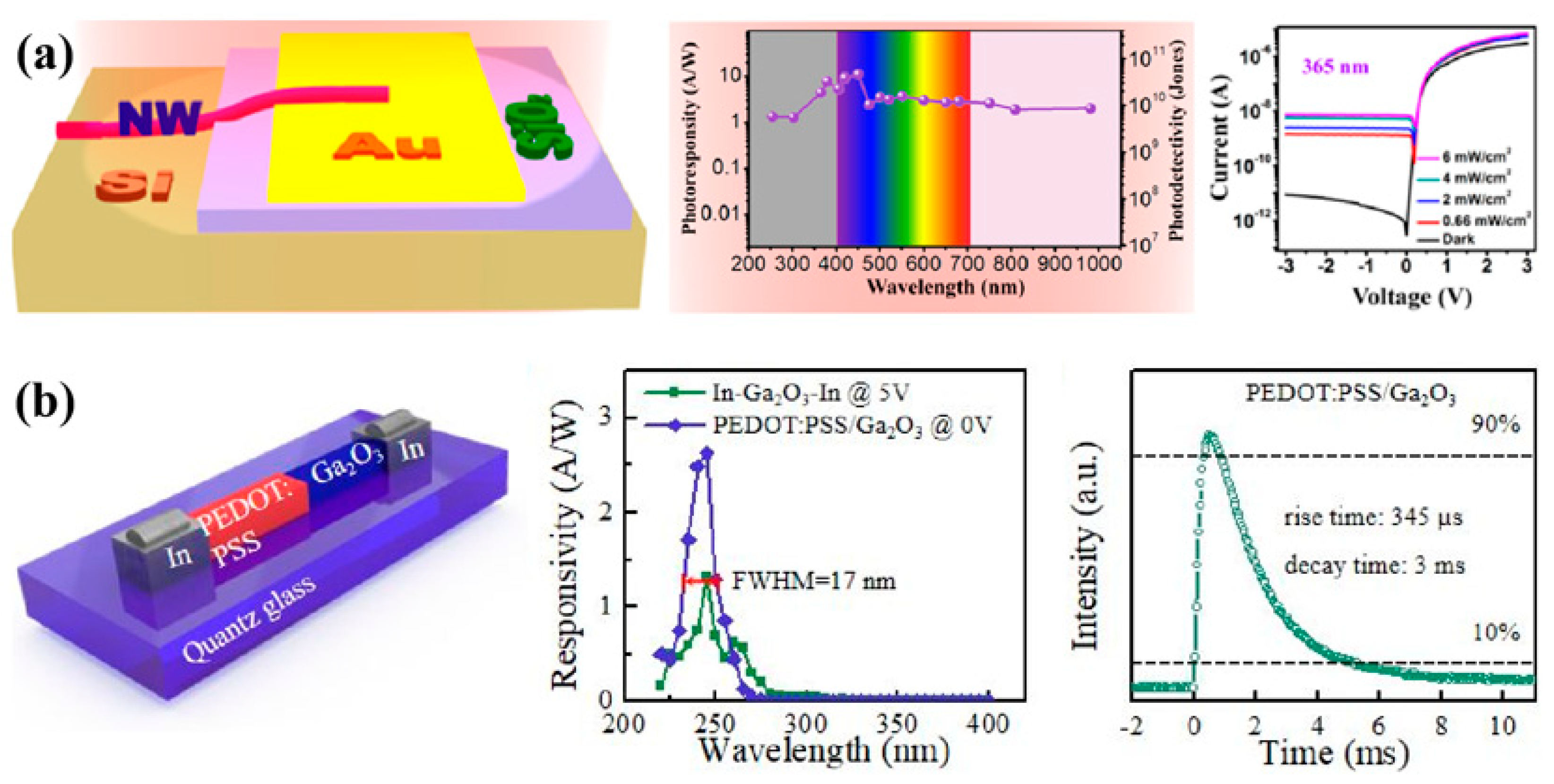
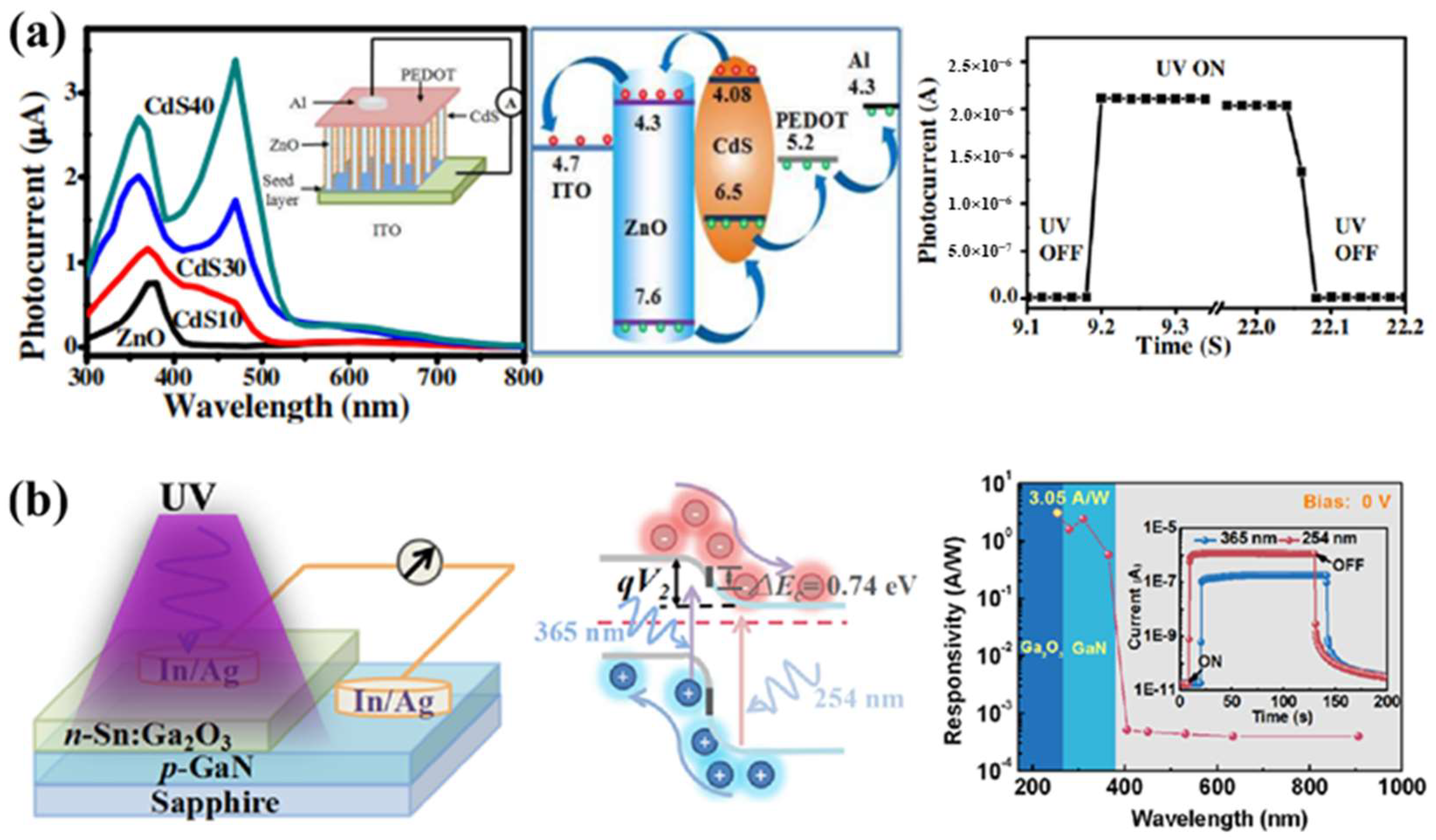
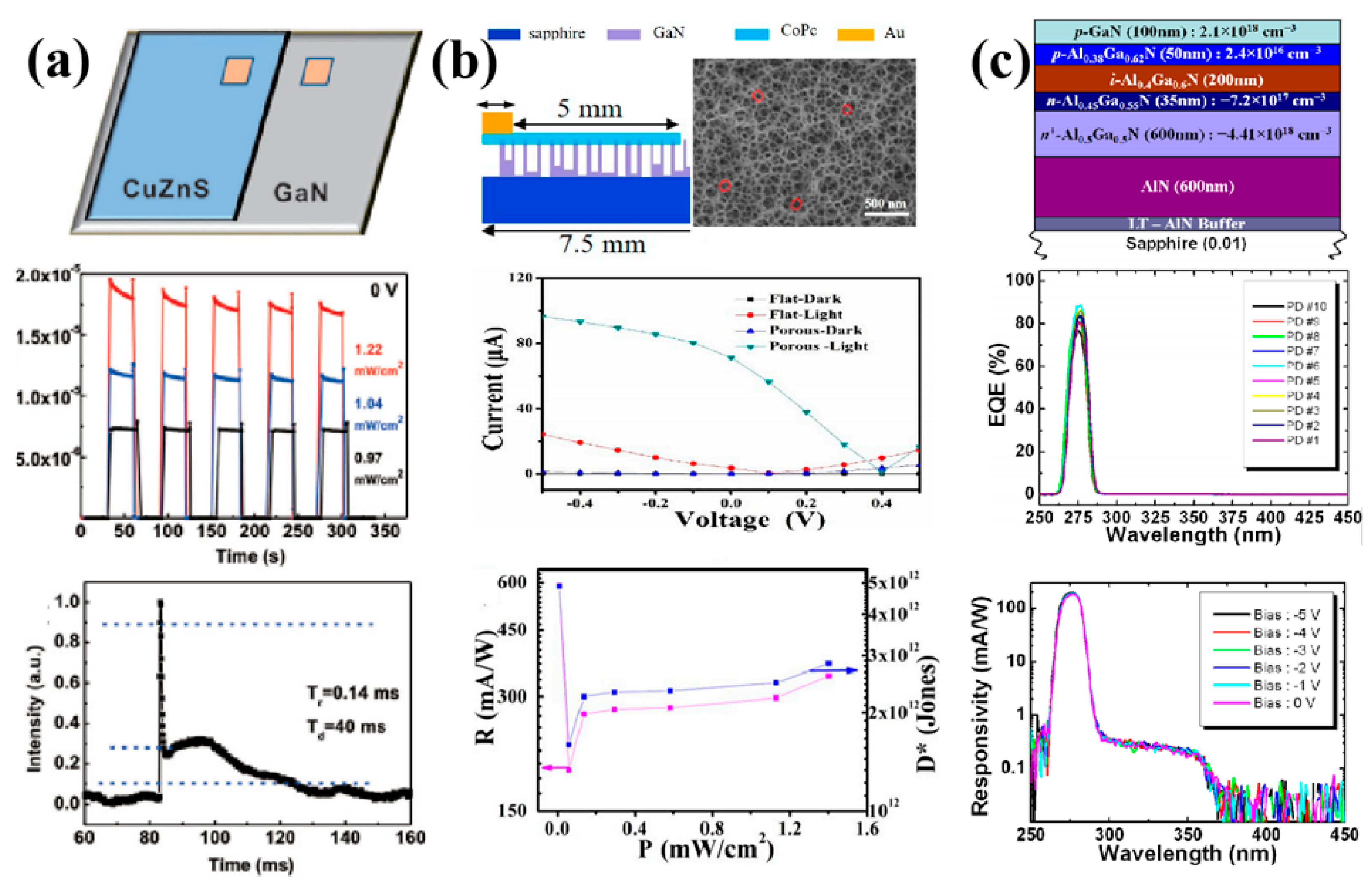
Publisher’s Note: MDPI stays neutral with regard to jurisdictional claims in published maps and institutional affiliations. |
© 2022 by the authors. Licensee MDPI, Basel, Switzerland. This article is an open access article distributed under the terms and conditions of the Creative Commons Attribution (CC BY) license (https://creativecommons.org/licenses/by/4.0/).
Share and Cite
Lin, H.; Jiang, A.; Xing, S.; Li, L.; Cheng, W.; Li, J.; Miao, W.; Zhou, X.; Tian, L. Advances in Self-Powered Ultraviolet Photodetectors Based on P-N Heterojunction Low-Dimensional Nanostructures. Nanomaterials 2022, 12, 910. https://doi.org/10.3390/nano12060910
Lin H, Jiang A, Xing S, Li L, Cheng W, Li J, Miao W, Zhou X, Tian L. Advances in Self-Powered Ultraviolet Photodetectors Based on P-N Heterojunction Low-Dimensional Nanostructures. Nanomaterials. 2022; 12(6):910. https://doi.org/10.3390/nano12060910
Chicago/Turabian StyleLin, Haowei, Ao Jiang, Shibo Xing, Lun Li, Wenxi Cheng, Jinling Li, Wei Miao, Xuefei Zhou, and Li Tian. 2022. "Advances in Self-Powered Ultraviolet Photodetectors Based on P-N Heterojunction Low-Dimensional Nanostructures" Nanomaterials 12, no. 6: 910. https://doi.org/10.3390/nano12060910





